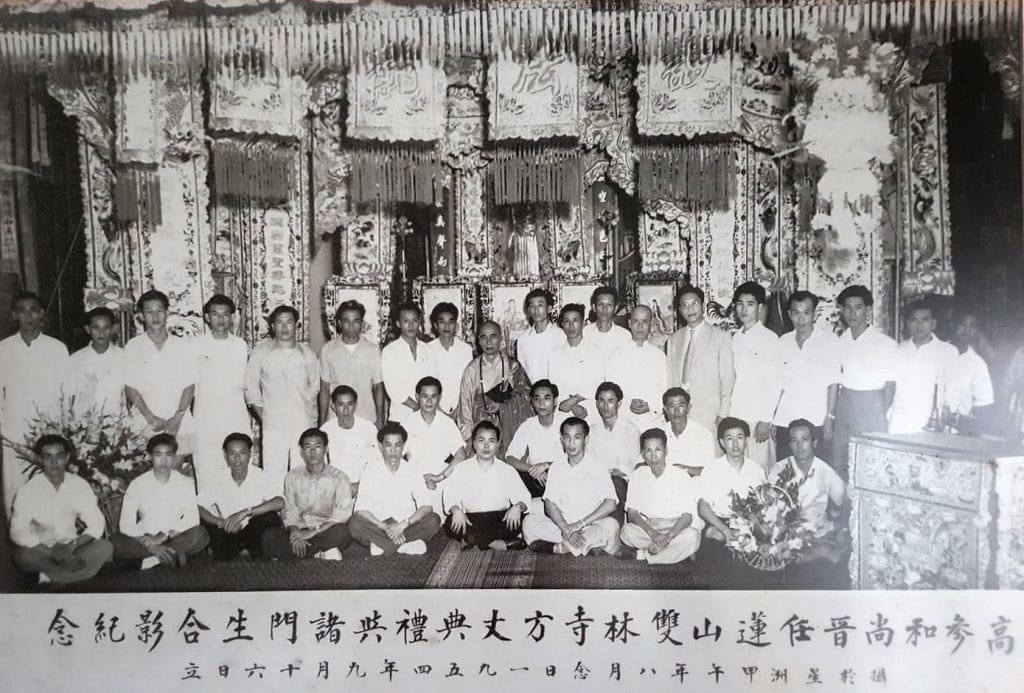
In the 1970s, Kung Fu films were popular in the Chinese film industry. I was in a secondary boy’s school, so I wanted to learn a few moves to defend myself. Many people in my class were interested in Kung Fu, so I teamed up with them to find a master. It was at that time that I discovered that most of the martial arts schools teaching Chinese Kung Fu were named after sports, research or fitness clubs, and many of them started with the word “Shao”.
When I asked a student who was familiar with the situation, he said that these were all Shaolin Kung Fu instructors and that the masters were all disciples of a local monk from Shuang Lin Monastery in Lianshan. I didn’t learn Kung Fu at the club that started with the word “Shao”, but I remembered that there was a monk from Shuang Lin Monastery.
I was one of the invited contributors to a commemorative anthology that Shuang Lin Monastery decided to publish to celebrate its 120th anniversary in 2018, I took the opportunity to learn more about this Kung Fu monk who seems to have stepped out of the movie screen. He is the 12th generation abbot of the temple: Master Gao Can.
Gao Can has only been at the temple for 12 years. In post-World War II Singapore, law and order were not good, and private gangs were rampant and a constant nuisance to the public. The temple was constantly harassed and threatened by hooligans. It was against this background that the 11th generation Master, Venerable Song Hui, invited Gao Can, a Shaolin Kung Fu practitioner, to preside over the temple. In 1948, at the age of 62, Gao Can left his 21-year tenure at Jinyuan Temple in Yogyakarta, Indonesia, to come to Singapore.
How did Gao Can deal with the harassment and threats of hooligans in those days? The answer to this question is not known. However, it is known that he took on disciples the year after he arrived in Singapore. One of his conditions was that disciples had to live in the temple for three years. Besides training in martial arts, disciples were also responsible for the menial work of the temple. By 1954, Gao Can have taken on 19 disciples, so could it be that the presence of this group of disciples was a deterrent to the evil-doers at Shuang Lin Monastery?
These 19 disciples were the primary force behind the spread of Shaolin martial arts in Singapore and Malaysia from 1954 onwards. In 1955, he established the Siau Hiong San Pugilistic Association (少雄山國術健身社) in Dapo. In 1956, he went north to Penang to rebuild the temple and set up the Penang Sao Lim Traditional Martial Arts Recreation Association (檳城少林傳統武術健身社). The establishment of three martial arts schools in three years was based on this group of disciples.
After the establishment of the association, how Gao Can accept and taught his students has changed. The disciples in charge of the martial art clubs select the most qualified students and send them to Shuang Lin Monastery for Gao Can himself to decide whether to accept them as his own students. These students do not have to live in the temple for three years. They only need to come to the temple after work to learn kung fu, and if they have work to do the next day, they can leave afterwards. Those who do not have to work will stay overnight and help with the temple the next day.
In 1958, a fourth martial arts school, the Singapore Seow Tin San Athletic Association (星洲少镇山國術體育會), was established. In order to co-ordinate the management of these clubs, Gao Can decided to set up the Nanyang Shaolin National Martial Arts Association (南洋少林國術總會), which was located at Shuang Lin Temple, with him as the chief instructor. It was also the year that the Temple held its first Three Great Precepts Ceremony since Buddhism was first introduced to Singapore.
After a lot of work, Gao Can fell ill and passed away on 16 May 1960. However, the disciples he had trained over the past 12 years had already taken up the baton of Shaolin martial arts. The number of member clubs grew steadily after 1960, reaching over 30. His students in Penang have also spread their Kung Fu to the UK. Photographs of foreign students of Shaolin Gao Can Mun Nam Pai Chuan can now be seen on the internet. This is something that Master Gao Can would not have expected when he first arrived in Singapore 70 years ago.
Source of Chinese Article: Foo Tee Tuan (2019), Old History of Shang Lin. Lianhe Zaobao. Translated by Simon Wang. Authorised to publish by Foo Tee Tuan.
